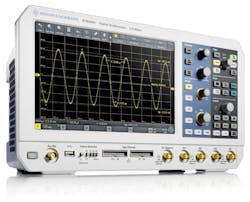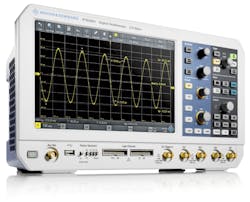ESC Boston and BIOMEDevice took place May 3-4, touting software tools, components, and test equipment for embedded designs, with the BIOMEDevice event adding a medical emphasis.
In a “fireside chat,” Scott Whitaker, president and CEO of the Advanced Medical Technology Association, discussed how the policies of the Trump Administration will impact the medtech industry and the current climate of medtech innovation. Whitaker said his organization takes no position on the insurance aspects of legislation now in Congress, emphasizing instead the repeal of the medical device tax imposed as part of the Affordable Care Act. As for the insurance aspects, Whitaker said his organization supports insurance for as many people as possible at the lowest cost possible but with support for the complete medical technology ecosystem.
Courtesy of Rohde & Schwarz
Edward Damiano of startup Beta Bionics offered a presentation titled “The Long and Winding Road to the Bionic Pancreas.” The company’s iLet would let diabetic patients carry their glucose metabolism in their pockets. He uses the term “bionic” rather than “artificial”—“artificial pancreas” would tell you what a device isn’t, whereas “bionic pancreas” is a descriptive term that tells you what it is, he said.
Also focusing on medical topics, Brahadeesh Chandrasekaran of Frost & Sullivan offered a keynote presentation titled “The Future Is Today: An Outlook on the State of the Medical Technologies Industry.” The emphasis, he said, is on keeping people healthier longer, with inpatient care declining while outpatient and ambulatory care is increasing in emphasis. He cited consumerization as driving change in the industry, adding that the smartphone is a gateway for healthcare information and is driving up efficiencies.
Addressing embedded-system design, Jan Niewiadomski, lead product developer at Intelligent Product Solutions, said that when it comes to the IoT, success is simple but not easy. He described his company as having an integrated team of 100-plus engineers skilled in electrical engineering, embedded software development, mechanical engineering, user-interface design, and production transition.
Any IoT project, he said, will involve technical challenges as well as external dependencies, security issues, and project constraints, including budgets, unit price, and schedules. A common problem, he said, involves feature-overthinking and trying to do too much. Don’t try to attack every single market need but rather focus on MVP—the minimum viable product.
Security was the focus of a keynote address by Michael Barr, Barr Group founder and CTO. “Our embedded systems are increasingly battlefields,” he said, as hackers safely in their bedrooms try to remotely injure or kill people around the world. He concluded with an action plan: Don’t ignore security, do adopt bug-reducing software best practices, do use cryptography where appropriate, do practice “defense in depth,” and do get and stay educated about security.
On the exhibit floor, instrument companies including Rohde & Schwarz, Teledyne LeCroy, Tektronix, Rigol, and Siglent highlighted bench test equipment including signal generators, analyzers, and oscilloscopes.
Rohde & Schwarz, for example, highlighted its R&S RTB2000 digital oscilloscope with 10-bit ADC, 10-Msample memory, and a 10.1-inch touchscreen. Teledyne LeCroy demonstrated the HDO9000 with HD1024 technology; the scope provides 10-bit resolution and a 4-GHz bandwidth. Pico Technology exhibited its PicoScope 4444, which makes differential voltage measurements at 14-bit resolution. And Siglent highlighted its SDS2000X Series Super Phosphor oscilloscopes available in bandwidths of 70 MHz, 100 MHz, 200 MHz, and 300 MHz with a maximum sample rate of 2 GS/s and with a maximum record length of 140 Mpoints.
Software products on exhibit spanned design, simulation, and test to real-time operating systems. Altium, for example, highlighted its PCB design tools while Green Hills Software described its RTOS offerings. In addition, Vector Software highlighted its VectorCAST software testing tools, and XJTAG highlighted its plug-in for Mentor Graphics’ PADS design platform.
Sockets also were on display as Ironwood showcased products including its Giga-snaP BGA adapters and its GT sockets for prototyping and testing BGA and QFN devices. Also, HSIO demonstrated its Grypper test sockets.
In addition, Technologic Systems exhibited its line of industrial single-board computers, including the new TS-7970. The TS-7970 takes advantage of the features of i.MX6 NXP CPU based on the ARM Cortex A9 core. The TS-7970 is suited for deployment in a range of applications including smart devices, auto entertainment systems, medical systems, enterprise-class intelligent control, and plant automation.
And on the BIOMEDevice section of the exhibit floor, Bristol Instruments highlighted its Model 157 optical thickness gauge, which employs optical interferometer-based technology to measure the thickness of a variety of transparent and semitransparent materials. Sensirion highlighted the SFM3400 proximal flow sensor for flow measurements in respiratory applications in neonatology. The neonatal sensor is available as single-use and as reusable solutions. The reusable version is autoclavable, washable, and sterilizable.
In a concluding keynote address titled “Enabling the Next Era of Human Space Exploration,” Jason Crusan, director, Advanced Exploration Systems, NASA Headquarters, Washington, D.C., described the challenges of sending humans into deep space. Deep space travel may have its roots in science fiction, but many of the challenges may seem less than inspiring to the imagination. Such challenges, he said, extend from supply-chain logistics to fire safety.
About the Author

Rick Nelson
Contributing Editor
Rick is currently Contributing Technical Editor. He was Executive Editor for EE in 2011-2018. Previously he served on several publications, including EDN and Vision Systems Design, and has received awards for signed editorials from the American Society of Business Publication Editors. He began as a design engineer at General Electric and Litton Industries and earned a BSEE degree from Penn State.

